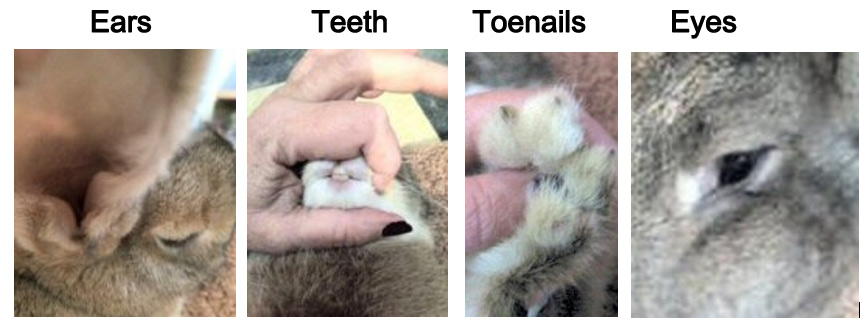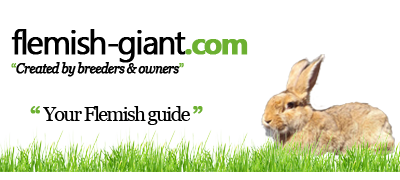After you have found & made arrangement to purchase a Flemish, from a reputable breeder, it is important to examine the rabbit over for any signs of illness or other problems. This needs to be done every single time you buy any rabbit, whether it is your first or your one-hundredth purchase.
HOW DO I EXAMINE A FLEMISH GIANT?
To examine him, you will need to first sit him on a solid surface. Pose him as he should be presented for showing. Gently look inside each ear. Is the skin clean & smooth or do you see sores or any ear-wax looking substance? If you see any, there is a problem with ear mites. Next, rub your hands over the length of his back. Do you feel any bones? Are there any patches of missing fur? Are there any signs of dandruff or flakey skin? If so, mention these things to the breeder. Feeling bones is usually an indication that the rabbit has not been eating correctly. When Flemish go through a heavy molt, they often will loose some flesh condition, though it should not be significant. Missing or patchy fur also is an indication of him molting, but if that is combined with flakey skin or dandruff, that Giant has fur mites. If it is severe, he probably has mange. Is the giant scratching? If so, be sure to also check for fleas. P.S. It is important to regularly include basic exams during yourdaily and monthly care routine

Make sure to check!
Inspect the head of your flemish giant
Next, with one hand on the top rump, place your other hand over the top of his head, with his ears held loosely, but securely, between your fingers. In a sweeping motion, flip the rabbit over. Do not pull on his ears when you do this. But use your other hand, slide down over his rump & pull forward in a swift motion. Once he is on his back, be mindful of those powerful hind legs – you don’t want to be kicked or scratched. Now, keeping your other hand over his head & ears, use your free hand to examine with. Look at his eyes, nose, & teeth. His eyes should be clear & bold. His nose should be dry & have no trace of mucous. Listen to his breathing. If he is making any rattling noises while breathing, you’re looking at respiratory problems. To check his teeth, using your thumb & forefinger, lift up his upper lip. Do his top teeth evenly overlap his bottom teeth? If you see anything other than this, there could be a serious problem called Malocclusion. If all those things check out well, then move on to his feet.
Inspect the feet of your flemish giant
Is there any wet or matted fur around his front paws? Such a thing is another indication of respiratory problems. Then, press the pad of your fingertip into the ‘palm’ of his front feet. You should feel 4 front toenails & one side toenail. All nails should all be the same color also. Next, slide your hand down his belly. As with the rest of his body, there should be no lumps felt anywhere. Proceed down to his hind feet, checking them for sores, raw spots, calluses, and toenails. His tail is next – it should be completely straight from the base to the tip, & well-furred. Finally, examine his genitals. There should be no presence of sticky or wet poo stuck to his fur, & his genitals should be clean. If you see any yellowish substance, the appearance of sores or ‘crust’, this is an indication of vent disease. Once you have finished, roll him back over, into sitting position. As long as those things are clear, you can be 80% sure that he is healthy. Remember, this basic exam is very important! If you are not comfortable with doing this yourself, do not be afraid to ask the breeder to show you how to do it. If asked, any good breeder will gladly help you, as well as teach you how to safely do it yourself.
OTHER MUST READ ARTICLES:+ : What do I feed my bunny?
+ : How to care?
+ : Sexing a flemish giant

